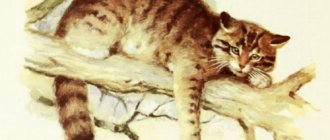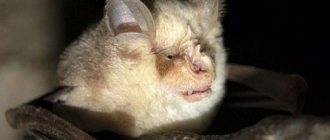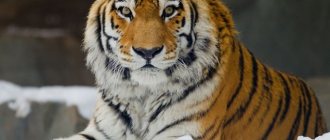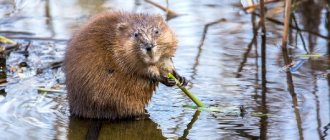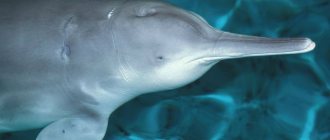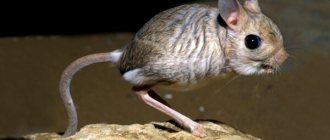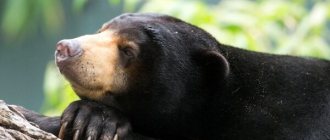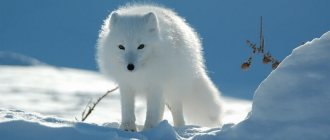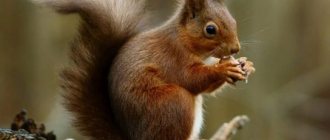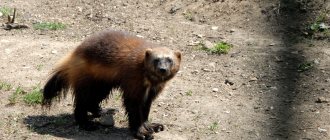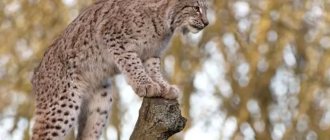Appearance
The river otter has a streamlined body shape, its length is from 55 to 95 centimeters, excluding the tail, which grows up to 55 centimeters. The animal weighs approximately 6 to 10 kilograms. The tail of the animal is not at all fluffy, but is equipped with a large number of muscles. The eyes are small, round, but located on the face so that the animal sees everything around very well. The animal has a thick neck.
The paws play a very important role for the river otter: they are short and webbed. The hind legs are longer than the front, this feature allows the otter to easily float on the water and swim quickly.
Otter jumping into the water
The fur of the animal below is colored silver or light in tone, but on the back and legs it is dark brown. The special structure of the hair allows the river otter not to get wet in the water. In spring and summer, the animal sheds, but the color does not change.
Interesting facts about the animal
River otters are considered intelligent and cunning animals. The animals skillfully camouflage their home, protecting it from possible encroachment by predators or humans. Often it is simply impossible to detect an otter burrow.
There are many interesting facts about river inhabitants that help you better understand this endangered species.
- There are only 3 species of otters in the entire world.
- The animal feels great in water. It can sleep on the surface of a reservoir, having previously wrapped itself in algae.
- In Bangladesh, people are successfully taming the animals, and they are helping to catch fish in nets.
- The eyes of animals are designed in such a way that they see perfectly both in water and on land.
- Otters are among the few animals that can swim on their backs.
- Status: Near Vulnerable was determined for the species in 2000.
- The animals live and feed only in fresh water bodies.
- While fishing, otters can get excited and catch much more fish than they need for food.
It is very interesting to watch how animals take care of themselves. In order to clean their thick fur from fish scales and adhering dirt, they bathe in a fun way. They dive, then swim to the surface, somersaulting.
River otters are very useful and funny animals. I wouldn't want the species to disappear completely. Endangered mammals must live and reproduce. Only people can change the current situation for the better.
Still have questions or have something to add? Then write to us about it in the comments, this will make the material more useful, complete and accurate.
Habitat
The animal is distributed throughout the western part of Europe; in addition, the otter’s range includes Asia. In our country it lives in almost all regions, even in the Far North.
Otter eats prey
The animal lives in rivers flowing in the forest, and even in lakes and ponds. There have been cases when a river otter was encountered on the sea coast. She chooses rivers that have ice-free rapids and a lot of windfall on the banks: here it is easier for her to hide and make herself a protected and unnoticeable hole.
The river otter’s home is also arranged in an interesting way: the animal enters its burrow directly under water. The otter lines its hole with grass. Each hole has two exits
An otter on the ice of a river eats a caught shellfish
Where does the otter live?
The otter lives mainly in fresh water; only 2 species prefer sea water - the sea otter and the cat otter. Otters always settle near water, although they can also move over long distances on land in search of habitat.
The animals are universal, and can live almost anywhere where there is water - in swamps and lowlands, on plains and savannas, in rice fields and sugar cane plantations, in tropical and deciduous forests, on the banks of small streams, lakes, deep rivers, on the seashore or ocean.
Lifestyle
The river otter is not always in the water, but the main part of its life activity is connected with the aquatic environment. Scientists have noticed that the otter can hold its breath and stay under water for two minutes. When on land, it moves sinuously, reminiscent of the movements of a snake. When he goes out on the ice, he almost glides across it.
Pair of otters
The otter is primarily a nocturnal animal. During the day, she prefers to sit in her “house,” but when it gets dark, she goes out hunting. This small animal is distinguished by its gluttony and even bloodthirstiness. Otters are also very cunning: when they are chased, they immediately run into the water. And they can even bite their enemy, and very hard at that!
River otters are solitary animals; they do not form colonies; sometimes, however, female individuals lead a cooperative lifestyle with each other. Otters live up to 10 years.
Baby otter
What does an otter look like?
The otter looks like a typical representative of the Mustelidae family - a long, flexible, squat body with short legs and a powerful, thick tail. The neck is quite short and muscular, a rounded head with a blunt muzzle, small rounded ears. The animal may close its ears and nostrils while diving.
It has sharp claws and webbing between the toes, although representatives of the genus Aonyx have very short claws or none at all. Otter fur is very dense and thick, almost waterproof. Species living in the tropics usually have shorter fur than northern species. The color is brown or brown with a reddish tint; the fur on the back is often darker, with a lighter shade underneath. The throat and chin are light in color or have white spots.
What does a river otter eat?
Of course, based on the lifestyle, the main food is fish, the animals especially love carp, pike and trout. But the otter can also hunt other inhabitants of the aquatic world. For example, she sometimes catches water rats, crayfish, frogs, and shrimp. If she doesn’t get enough of aquatic animals while hunting, she can look for “food supplements” on land. Rabbits, birds and other rodents sometimes become its victims. In addition, she can eat plant foods.
Otters at the zoo studying a toy
Description and origin of the species
The animal received the first scientific description, and the scientific name Lutra lutra
from the Swedish zoologist Carl Linnaeus in 1758. The name "otter" came into Slavic languages from the ancient Indian udras, which literally means aquatic animal. In Latin the animal is called lutra, hence the name of the genus. The genus Lutra now includes only 2 species - the Sumatran and Eurasian otters, and the Japanese extinct species.
Animals living in the New World were also initially classified in the otter genus Lutra, but later they were separated into a separate genus Lontra (American otters). Now this genus includes 4 species - Canadian, cat, long-tailed and southern otters.
Clawless otters are also classified as a separate genus. Initially, these animals belonged to the genus of otters Lutra, but due to their peculiarity - the absence of claws, they were separated into a separate genus of clawless Aonyx. The name of the genus is translated from Latin as “without claws”, and is formed from the word onyx (claw) and the prefix a- (without). This genus includes 3 species - Asian, African and Congo clawless otter.
Other species—the sea otter, the Brazilian giant otter, the smooth-coated otter, and the white-throated otter—were also transferred from the genus Lutra to separate genera due to the unique morphological features of these animals.
Breeding offspring
The mating season for otters occurs in the first months of spring; in some climatic zones this process is year-round. Mating occurs in water. The female carries the offspring for about 63 days, although the entire pregnancy is 270 days. One female gives birth to 2 to 4 puppies (that’s what baby otters are called). At birth, small otters cannot see anything at all. The cubs fully mature by two or three years of their life. Already at this age they are able to have their own offspring.
https://youtu.be/i0HVcBckgZU
Character and lifestyle
The animal's lifestyle varies greatly depending on the species. For example, the Asian clawless otter lives in groups of up to 15 individuals and is active primarily at night. Sea otters hunt during the day and alone, while individuals of the same sex gather in flocks of up to 100 individuals to rest. Smooth-coated otters hunt during the day and live in groups of up to 11 animals.
Canadian otters are the most social animals of all species. The animals live in large families of up to 17 individuals and do everything together - share shelter, prey, hunt, rest, lick and groom each other. Giant otters live similarly, only with a rigid hierarchy and social structure united around a dominant pair of individuals. Southern river otters, living in southern Latin America, on the contrary, are prone to loneliness and live alone, except for mothers with cubs.
The Eurasian otter is the most territorial species, actively defending its own territory. The rest of the animals calmly share the territory with their relatives. Giant Brazilian otters defend the group's common territory from other families. Otters are usually very talkative and make more than 20 different sounds.
Status of the species in nature
Since 2000, the common otter has been listed as a “vulnerable” species by the International Union for Conservation of Nature.
Coastal development, deforestation, river pollution with sewage, active fishing - all this deprives otters of their original habitats and food supply. For a long time, otters were mercilessly exterminated for their beautiful waterproof fur. As a result, the total number of otters living in the wild has decreased significantly. The use of pesticides in agricultural activities also negatively affects their numbers.
general characteristics
All representatives of the species are quite large animals, which nature has endowed with a flexible, elongated, streamlined body. Thanks to this feature, otters swim perfectly both above and under water. On average, the body length, depending on the species, can be from 50 to 100 cm. The tail is from 20 to 60. The weight of adults is from 10 to 26 kg. Sexual dimorphism is weak, usually males are slightly larger and more massive than females.
Otters have short, powerful legs and have membranes between their toes. There are species with and without claws. The tail is muscular, covered with short fur, and does not fluff.
The head is round, like the whole body is streamlined, the mouth is slightly blunt. The ears are semicircular and small in size. A unique feature of otters is that underwater, the nasal openings and ears close, which allows the animals to feel comfortable while swimming and hunting.
The entire body of animals is covered with dense, waterproof fur. The thick undercoat perfectly insulates the otter’s body from moisture and hypothermia. In almost all species, the fur is brown or dark brown in color. Usually the lower part of the body is colored in lighter colors from beige and white to silver.
Otters do not store fat and do not hibernate. The only way to survive in cold weather is regular food and warm burrows. Therefore, if a reservoir runs out of fish, otters leave their usual areas and migrate in search of food.
Elena
Ask a Question
Question to the expert
What sounds can otters make?
The sound range of waterfowl is very diverse. Otters may hiss, snort, or chirp when scared. When communicating within a species group, they yap, squeak, squeal, and hoot. During a fight, animals howl or make sharp yapping sounds. Tamed otters use yelps and howls to beg for food or affection.
Social structure and reproduction
Photo: Animal otter
The interaction and communication of various species of otters have their own characteristics and differences. Sea otters, for example, live in groups where both males and females are present. And the Canadian otter prefers to form groups of only male individuals, entire bachelor squads numbering from 10 to 12 animals.
Fun fact: River otters are loners. Females, together with their broods, live in the same territory, but each female tries to allocate her own separate area on it. The male’s domain includes areas of a much larger area, where he lives completely alone until the mating season begins.
Pairs are formed for a short period of mating, then the male returns to his usual free life, taking absolutely no part in communicating with his children. The breeding season usually takes place in spring and early summer. The male judges the female’s readiness for approach by her specific smelling marks left behind. The body of otters is ready for reproduction at two (in females) and three (in males) years of life. To win the lady of their heart, cavalier otters often engage in tireless fights
The female carries the cubs for two months. Up to 4 babies can be born, but usually there are only 2. The otter mother is very caring and raises her babies until they are one year old. Babies are born already in a fur coat, but they see absolutely nothing, they weigh about 100 g. After two weeks they begin to see clearly and their first attempts begin.
Closer to two months, they are already starting swimming training. During this same period, their teeth grow, which means that they begin to eat food that is typical for them. All the same, they are still too small and exposed to various dangers; even at six months they stay close to their mother. A mother teaches her offspring to fish, because their lives depend on it. Only when babies turn one year old do they become fully strengthened and adults, ready to go free swimming.
Population and protection of the species
Population status varies greatly depending on the species and region.
The main threats to the animal are:
- reduction of natural habitat - especially relevant for sea otters, giant and North American otters;
- poaching, illegal trapping and hunting for skins - this problem is most acute in Southeast Asia and Africa;
- pollution of rivers and reservoirs - Canadian and Eurasian otters, as well as animals of Southeast Asia, are especially affected.
Otters are listed in the International Red Book:
- Only the Canadian otter has Least Concern (LC) status;
- Near Threatened (NT) are the African clawless otter, Congo clawless otter, long-tailed (Neotropical), Eurasian and white-throated otters;
- vulnerable species (VU) - smooth-coated and Asian clawless otters;
- The most endangered species are the sea otter, southern river otter, cat otter, Sumatran otter and giant otter.
Natural enemies
Otters spend most of their lives in water, where there are few natural enemies. Animals are in much greater danger on land.
Natural enemies:
- alligators and crocodiles;
- killer whales, sharks;
- seals;
- cougars;
- caymans;
- wolves, coyotes;
- jaguars;
- the Bears;
- lynx;
- foxes;
- eagles and owls (prey on young);
- pythons, anacondas;
- domestic dogs.
Humans also play a significant role in the extermination of species. The animals are hunted for their fur and their natural habitat is destroyed.
Elena
Ask a Question
Question to the expert
How long does an otter live in the wild?
On average, otters live from 10 to 15 years. But there is information about centenarians who lived to be 20–25 years old. Scientists note that the average life expectancy of females in the wild is 3-5 years longer than that of males.
Factors negatively affecting numbers
The decrease in the population of the Caucasian otter in the 1960-1970s was influenced by the construction of pond systems, reservoirs, rice farms, etc. In mountainous and foothill areas, the reason for the decrease in the population is the destruction of forests, which, in turn, caused an increase in surface water flow and a decrease freshwater inhabitants (crayfish, fish, frogs, etc.), which are natural food for otters.
In addition, the reduction in the number of animals was influenced by the fact that many water bodies were polluted through toxic chemicals, pesticides, oil, etc. It should also be noted that the population is negatively affected by poaching.
In order to partially restore the population of Caucasian otters, it is necessary to create nurseries and resettle the animals across the lands. In addition, the fight against poaching should be significantly strengthened, as well as responsibility for illegal hunting of animals and trade in their fur should be strengthened.
Video
Nutrition
The otter is a semi-aquatic animal. Many river dwellers form a large part of its diet. The otter's food can be carp, roach, crucian carp, gobies and even small pike. Prefers small fish.
In winter, when there is not enough food, it eats frogs, crayfish, and all kinds of larvae. In addition to fish, it hunts water voles, ducks, waders, and small rodents.
